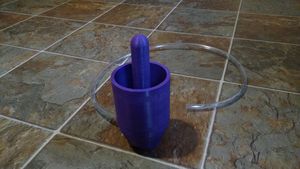
- poor geometric design for function
In much of the developing world it is very common to collect water in a bucket this water is then used for around the house needs. Having the water in a bucket however can make it somewhat difficult to use as you have poor control when pouring the bucket out. The simple solution and the one that many people use its to use some sort of cup in the bucket. My design uses a 3D printable pump to allow the user to pump the water out. This has several advantages. It allows better control of the amount of water being used and therefore has the potential to decrease water usage meaning that you will need to fill your bucket less often. Also because you can attach a hose to the pump you can have lots of control over where thew water goes and can reach many places while leaving the bucket in one place the whole time. Also unlike mounting a spigot to the bucket this design does not require you to drill a hole into the bucket and does not require the bucket to be elevated above where you wish to pour the water. Also any leaks in the pump will simply go back into the bucket meaning that a leaky pump will just be less effective but not cause any catastrophic leaks.
Bill of Materials[edit | edit source]
- Filament
- 3/8" Hose (1/2" OD, 3/8" ID)
- Petroleum Jelly or other food safe waterproof lubricant
CAD files and STLs
- All of the source files for this design can be found here | Youmagine Link
Tools needed[edit | edit source]
- MOST Delta RepRap or similar RepRap 3-D printer
Skills and knowledge needed[edit | edit source]
This project is quite simple and requires no special skills.
Technical Specifications and Assembly Instructions[edit | edit source]
- Assembly
- Put desired length of hose into hole.
- Insert the check valve flap into the pump ensuring that it lays flat on the bottom.
- Lubricate the sides of the pump and of the piston with petroleum jelly (optional step but it will greatly increase pump performance)
- Slide the piston into the pump.
- Print Time estimate:
- Include assembly time estimate: 9 hours
- Including drawings or pictures of the device at stage of assembly at minimum. (Upload)
Use Instructions and tips[edit | edit source]
- Operation of the pump is quite simple and is done by simply pumping the piston up and down.
- The pump requires more than 1 cm of water in the bucket
- Shorter lengths of hose will work better.
Common Problems and Solutions[edit | edit source]
- Tolerances around piston are too tight or too loose.
- Depending on the printer used the tolerances of the piston may vary a bit.
- If the tolerances are too loose you can use electrical tape around the piston.
- If the tolerances are too tight you can sand the piston down slightly.
Cost savings[edit | edit source]
- Estimate of costs
- Filament $3.91
- Hose $0.78
- Petroleum jelly
- A commercial Bucket pump can be bought for around $30.
- Cost savings of $25.31